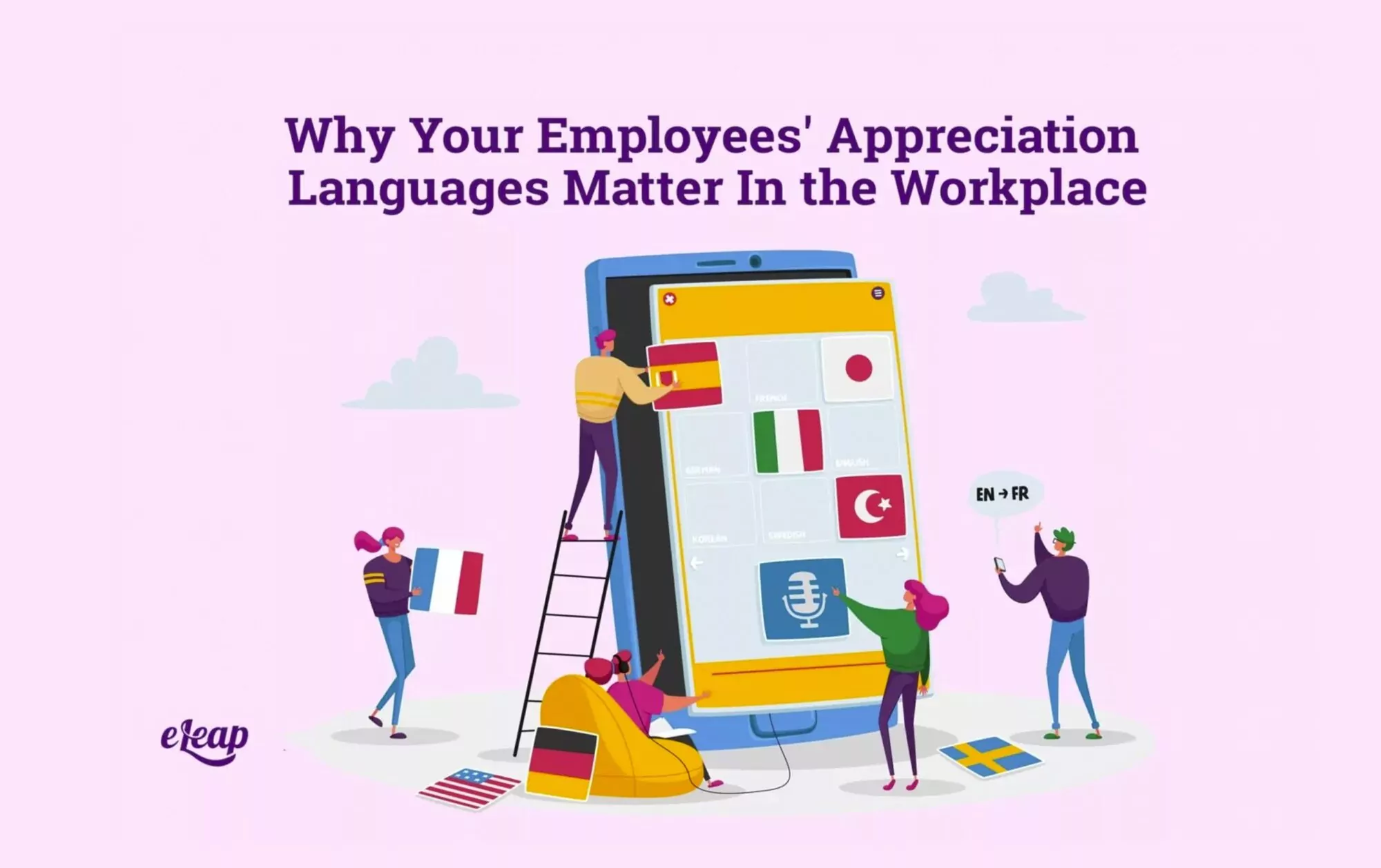Why Your Employees’ Appreciation Languages Matter In the Workplace

Knowing your employees’ appreciation languages is crucial. When you have this information, you can let your team know they’re doing a great job in a way that makes an impact on them individually. However, in order to know this information, you need to know what the appreciation languages are!

What Are the Appreciation Languages
The workplace appreciation languages come from the Five Love Languages that Gary Chapman introduced in the 1990s. In 2012, he worked with Dr. Paul White to create and release the Five Languages of Appreciation in the Workplace. While different than the love languages of couples, these languages of appreciation have similar ideas, simply executed differently.
Let’s look at the five appreciation languages and how to use them while at work.
Words of Affirmation
Research shows that almost half of workers in the United States respond best to words of affirmation. This appreciation language focuses on using either written or spoken words to praise an employee. While you may think this is the most straightforward way to show appreciation, there are right and wrong ways to do it.
First, you want to make sure you’re specific with your praise. Saying blanket phrases like “great work!” isn’t what employees are looking for if they thrive in affirming words. When you’re giving your employee praise through words, consider these three elements:
- Mention the situation, so they understand the context of your praise
- Be specific about the behavior that you’re praising
- Explain the impact that the employee made on either you or the workplace as a whole
You also want to make sure to speak words of affirmation at the right time. Waiting until a quarterly review or monthly meeting is likely to lessen the impact your words will have on your employee. Instead, make it a priority to let your employees know when they’ve done something positive. The sooner you give the praise, the most it will mean to your employees!
It’s also important to note that not every employee who prefers words of affirmation wants them delivered in the same manner. Some people thrive off public praise, while others hate being the center of attention. Don’t be afraid to use different methods of providing praise. You can give public praise, verbal praise during a one-on-one meeting, or even send an email or drop a card on the employee’s desk!
Quality Time
About a quarter of American workers thrive most on quality time with their manager. When it comes to the workplace, quality time looks like getting undivided attention in a one-on-one manner, where the employee feels they’re the most important part of your meeting.
When you’re balancing a full team, whether in-person, remote, or a mix of the two, it can be hard to balance proper quality time for those employees who need it. However, let’s look at some tips on handling this appreciation language properly!
Employees who crave quality time need time that’s dedicated to mentoring. In order to make the largest impact possible on these employees, make sure you’re providing ample opportunities for mentorship. These opportunities don’t always have to be formal meetings but can be quick tips or advice when they ask for it.
It’s also important to handle check-ins with extra care when working with these employees. Check-ins are essential for all employees, but they’re even more crucial when an employee’s appreciation language is quality time. When providing a one-on-one meeting, make it clear that your focus is on them and their improvements.
Another extra way to make an impact with these check-ins is to get (appropriately) personal. Ask your employee how their day is going, how their kids or pets are, or something else that shows you are truly invested in them as a person.
When it comes to quality time, it’s also important to remember these employees are likely craving quality time with their teammates as well. Give employees plenty of opportunities to hang out in low-key environments. Consider happy hours, lunches, or other fun activities to help your team make connections with one another!
Acts of Service
A little over 20% of your employees are likely to have acts of service as their appreciation language at work. As employees, acts of service will look like small acts done throughout the day that are for support, motivation, or simply to make them smile.
Acts of service can take some pre-planning or can be a spur of the moment, so it’s a good idea to have ideas for both. Let’s consider some tips on making a difference for these employees.
One great way to show appreciation for your team members who prefer acts of service is by volunteering to do a task when you can. The task you take on doesn’t have to be a large one, just one you have the time to devote to it. Being proactive with this can make a huge difference.
Smaller acts of service can include bringing coffee for your team or buying snacks or dinner for employees when they have to stay late to work on a project. These acts don’t have to be ones that take up a huge chunk of your day for them to make a difference.
It’s also crucial to remember to consider all levels of seniority when looking for acts of service you can do. Anytime you see someone who is having issues handling or delegating their tasks, offer to help them out. While the help may look different for different levels, the impact your offerings make will be the same!
Gifts
On average, around six percent of your workforce will appreciate gifts more than the other appreciation languages. It’s important to remember that this language isn’t requesting raises and bonuses regularly but tangible gifts that are relevant to what they are passionate about.
When it comes to giving gifts in the workplace, it’s important to take time and learn about their interests, passions, and what they want or need. Getting to know your employees is the easiest way to learn this information, including asking specific questions to get the information you’re looking for.
Another option in the gift-giving area is gifting an extra paid day off to your employees. Almost half of all workers feel that this is in their top three best gift options in the workplace. When you gift an employee one of these days, emphasize the importance of using it to do something they love.
You should give gifts based on when your employees reach certain goals so that you have a measurable way to determine when to give them. Of course, you can also give smaller gifts randomly, though it’s important to be careful to avoid potential favoritism concerns when doing so.
Physical Touch
Less than one percent of American workers desire physical touch as their main appreciation language. However, it’s still important to know how to approach the area correctly and professionally in case someone on your team requests it!
First, it’s best to make sure you aren’t making assumptions about the type of physical touch your employees have in mind. Some employees may be comfortable with hugs or pats on the back, while others may just desire a high-five. Always ask for permission before taking part in any physical touch.
It’s also crucial to respect the boundaries of everyone in the workplace when it comes to physical touch. Don’t take it personally if someone requests you don’t touch them. It likely just means they prefer to keep their personal space, and that’s okay!
Things to Remember About Appreciation Languages
Now that you know the five appreciation languages in the workplace, there are some tips to keep in mind when it comes to utilizing them with your team. Remembering these points will help you make sure you’re approaching each employee correctly!
Keep these ideas in mind:
- Your employees are likely to all have different preferences of appreciation
- Not everyone wants words of praise, even though it’s the most common type of appreciation in the workplace.
- Don’t forget about the people in positions above you when it comes to appreciation – all levels deserve personally driven acts of appreciation!
- You’ll make the biggest impact on your employees when you show them appreciation regularly that feels authentic and personal.
In order to have the right tools and knowledge needed to begin utilizing appreciation languages in your workplace, you need to know where each employee stands. To do that, have your employees take the Appreciation Languages Quiz to find out what their preference is.
With this information collected, it’s up to you to show appreciation for your employees in ways that are genuine, personal, and meaningful.
Takeaway
Appreciation is a huge part of cultivating a healthy workplace culture. Knowing how to show your team members that you appreciate what they do for your business is the best way to make that happen. Take time to learn the appreciation languages of everyone on your team, then use that information to your advantage! The difference it makes will surprise you!
The eLeaP continuous performance management system provides organizations with powerful options to attract and retain high caliber team members.